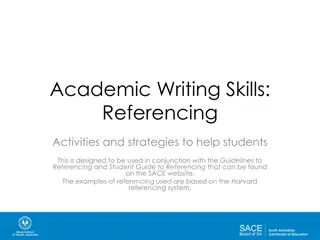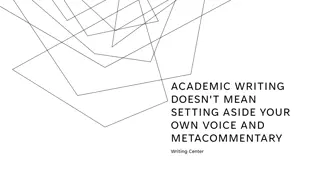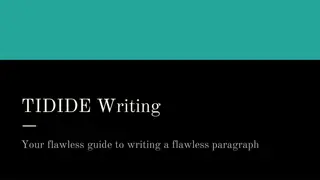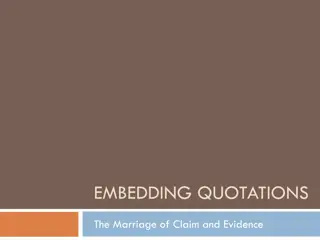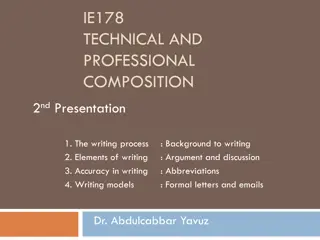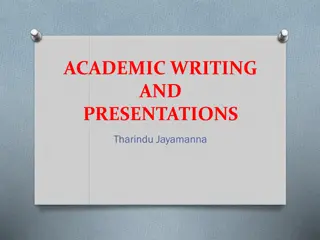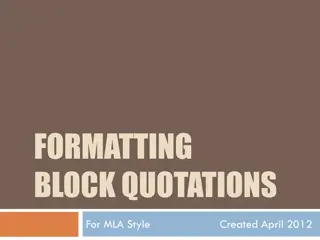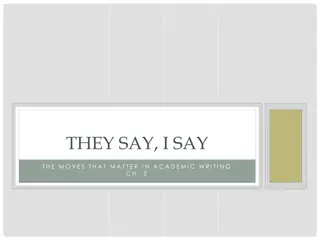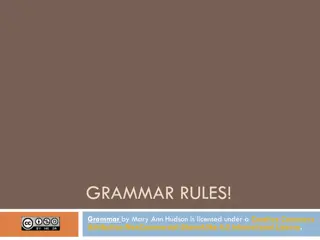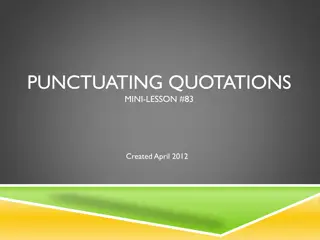Mastering Quotations in Academic Writing
Learn why and how to use quotations effectively in your academic writing, with insights from experts like Statics and Henry Petroski. Understand the importance of the "quotation sandwich" method, distinguish between good and bad quotations, explore different types of quotations, and follow the rules for block quotations with examples to enhance the credibility of your work.
Download Presentation

Please find below an Image/Link to download the presentation.
The content on the website is provided AS IS for your information and personal use only. It may not be sold, licensed, or shared on other websites without obtaining consent from the author.If you encounter any issues during the download, it is possible that the publisher has removed the file from their server.
You are allowed to download the files provided on this website for personal or commercial use, subject to the condition that they are used lawfully. All files are the property of their respective owners.
The content on the website is provided AS IS for your information and personal use only. It may not be sold, licensed, or shared on other websites without obtaining consent from the author.
E N D
Presentation Transcript
USING QUOTATIONS With examples from Statics and Henry Petroski Sarah Livesay, PhD Assistant Director Hanson Center for Technical Communication
WHY USE QUOTATIONS? 1. To demonstrate familiarity with a text. 2. To emphasize a point that you wish to make. 3. To provide direct evidence supporting your claim.
THE QUOTATION SANDWICH All quotations must be put into a sandwich within your writing: First, introduce the quotation (the top piece of bread). Introducing it lets the reader know what is coming and why it is important to consider. Next, provide the quotation itself (the meat). Quote and cite in the proper format. Finally, explain your quotation and help your reader understand what was useful about it (bottom piece of bread). This means that you should almost never end a paragraph with a quotation.
GOOD VS. BAD QUOTATIONS Good quotations: Are properly cited. Are directly relevant to the material discussed. Do not contain (much) extraneous/unnecessary material. Are sandwiched appropriately in the text. Bad quotations: Lack proper citation. Are irrelevant to the current material or only a little relevant. Contain a lot of material that isn t discussed or mentioned. Lack an appropriate intro or analysis before and/or after.
TYPES OF QUOTATIONS 1. Block Quotations: long sections of text. 2. Full Quotations: full line(s) of text. 3. Integrated Partial Quotations: sentence fragments quoted inside your own sentences.
BLOCK QUOTATION RULES When you choose to provide a long quotation, you suggest that everything that you quote is important. Only do it if you intend to refer to and make use of everything you ve quoted. In APA, block quotations are set off from the rest of the text, double- spaced, and indented .5 inches. Often they are introduced with a colon. Cite the source after the final punctuation. If you use lineated text (poetry or plays), you need to maintain the lineation in a block quotation. Likewise, if you are quoting across paragraphs, you need to indicate the new paragraph with additional indentation.
BLOCK QUOTATION EXAMPLE Petroski explains the distinction between engineers and scientists in his essay Failure is Always an Option : A common misconception about how things such as space shuttles come to be is that engineers simply apply the theories and equations of science. But this cannot be done until the new thing-to-be is conceived in the engineer's mind's eye. Rather than following from science, engineered things lead it. The steam engine was developed before thermodynamics, and flying machines before aerodynamics. The sciences were invented to explain the accomplishments and to analyze their shortcomings. (2003) Here Petroski identifies the engineer not as an analyst, but as the creator of a new thing-to-be. Engineering is inherently risky because of the expectation placed on engineers to lead breakthroughs before the science is even created to explain the field. The block quotation is set off with an indentation and is without quotation marks. The analysis that follows it begins to pick up on the details of the quotation, though still more analysis is needed in a full paragraph to justify the use of a long passage.
EDITING QUOTATIONS Often when quoting, you will want to distinguish between useful information and unnecessary material. You can cut material from any passage with an ellipsis, which looks like this: Using ellipses, you can edit the following quotation to more a relevant and manageable length: Original quotation: But engineers do know that nothing is perfect, including themselves. As careful and extensive as their calculations might be, engineers know that they can err and that things can behave differently out of the laboratory. (Petroski, 2003) Modified quotation: But engineers do know that nothing is perfect and that things can behave differently out of the laboratory. (Petroski, 2003) Some redundancy or repetition is cut, indicating that the repeated phrases will not be the central focus of the analysis.
FULL QUOTATION RULES Whatever you quote should have purpose in your essay. Use a full sentence quotation only if you intend to handle most if not all of the material, and if the sentence is especially interesting or well-written. Full quotations can be part of your own sentences, set off with a comma, or set off with a colon at the end of a sentence. When dealing with lineated texts, use a slash to separate the lines.
FULL QUOTATION EXAMPLE As Petroski (2003) writes about the engineer s ability to predict, No one knows a machine or its failure modes as well as the engineers who created it, and even they know it only as well as it reveals itself to them. The failure of an engineered object, in other words, can best be predicted by its engineers, but only to a certain degree. It is still unreasonable to expect engineers to know perfectly how a machine will behave. Here you can see the full quotation inside the writer s own text. The quotation is introduced, quoted, and then analyzed at length. The quotation contains very little extraneous material and demonstrates interesting writing that supplements the essay without overwhelming it.
INTEGRATED PARTIAL QUOTATION RULES This is often the best way to quote a source text, since it uses just the parts of the text that you need. This process also tends to lead to a more creative and interesting use of sources. Integrate the quotation directly into your sentence. Use quotation marks and a citation, but make the transition as seamless as you can into your own writing. If you need to alter a statement to fit the grammar and syntax of a sentence that you are writing, you can use brackets to add words or adapt them. Just stay as close to the original text as possible and maintain the spirit of its ideas.
INTEGRATED PARTIAL QUOTATION EXAMPLE The full quotation used below reads: Much of design is thus defensive engineering: containing, shielding and fending off anticipated problems on the drawing board and computer screen so that they cannot bring down the design when it flies. Obviously, total success can only come if every possible mode of failure is identified and defended against. The quotation partially integrated into the essay reads: Petroski (2003) calls preparing for failure a form of defensive engineering, in which engineers attempt to [fend] off anticipated problems before their design is implemented in a real world context. But in the case of failures such as the one analyzed here, the design could not be completely tested because of a rushed timeline from project managers, therefore putting engineers in a position in which total success was impossible because every possible mode of failure [could not be] identified and defended against (Petroski 2003). Here the quotation works directly into the writer s sentences. It fits into the syntax and reframes the quotation within the essay s own grammatical structure rather than that of the quoted source.
FINAL THOUGHTS ON QUOTATIONS Quotations are a necessary part of the analysis process for any paper with an argumentative component. Randomly using quotations doesn t help your paper. Use them wisely! Make sure that whatever you choose to include is useful and necessary for your paper.


